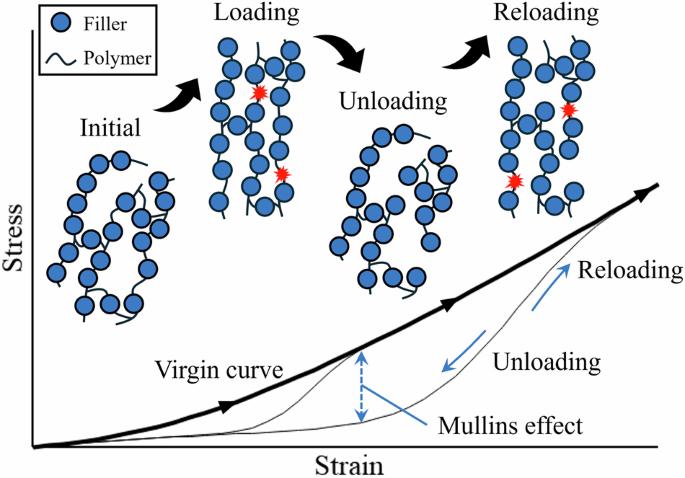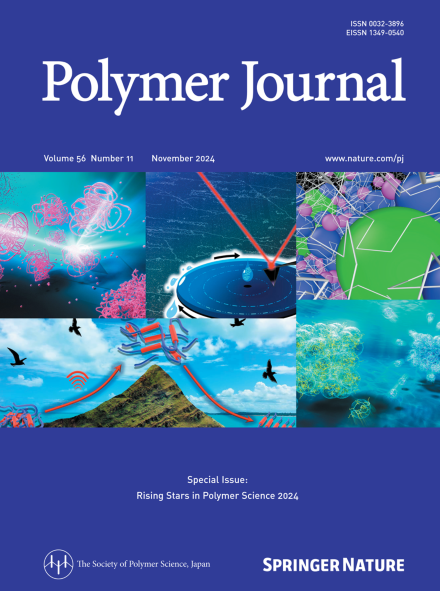A heuristic study of the Mullins effect in reinforced rubber by using the Weibull distribution
IF 2.7
4区 化学
Q3 POLYMER SCIENCE
引用次数: 0
Abstract
Stress softening, known as the Mullins effect, has a significant effect on the durability and performance of filler-reinforced rubber, making it a critical issue in designing products for practical applications. While empirical equations are widely used, they fail to capture the intricate and nonlinear behaviors that are characteristic of filler-reinforced rubber. To address this limitation, this study developed a simplified equation to predict the Mullins effect. The model is based on the assumption that the Mullins effect originates from the destruction of particle aggregation structures, and the relationship between the degree of destruction and the stretch ratio is expressed using extreme value statistics. Validation against experimental data revealed that the equation accurately predicts the behavior of rubber reinforced with carbon black (CB) or silica. Additionally, in systems with CB-filled rubber, the equation demonstrated good agreement with the experimental results, even when the CB content was varied. These findings suggest that the proposed model is versatile and effective for predicting the Mullins effect under different conditions, providing a useful tool for understanding and optimizing the performance of filler-reinforced rubber in practical applications. Stress softening, or the Mullins effect, critically affects the performance of filler-reinforced rubber. This study proposes a simplified model based on the destruction of particle aggregates, using extreme value statistics to relate damage to stretch ratio. The model accurately predicts behaviors of rubber filled with carbon black or silica, showing good agreement with experiments across varying filler contents. It offers a practical tool for designing durable rubber materials.

基于威布尔分布的增强橡胶Mullins效应的启发式研究
应力软化,被称为马林斯效应,对填充增强橡胶的耐久性和性能有重大影响,使其成为设计实际应用产品的关键问题。虽然经验方程被广泛使用,但它们未能捕捉到填充增强橡胶的复杂和非线性行为特征。为了解决这一限制,本研究开发了一个简化的方程来预测穆林斯效应。该模型假设Mullins效应源于颗粒聚集结构的破坏,破坏程度与拉伸比之间的关系采用极值统计量表示。对实验数据的验证表明,该方程可以准确地预测炭黑或二氧化硅增强橡胶的性能。此外,在CB填充橡胶体系中,即使CB含量不同,该方程也与实验结果吻合良好。研究结果表明,该模型具有通用性,可有效预测不同条件下的Mullins效应,为实际应用中理解和优化填充增强橡胶的性能提供了有用的工具。应力软化或马林斯效应严重影响填充增强橡胶的性能。本文提出了一种基于颗粒聚集体破坏的简化模型,利用极值统计将损伤与拉伸比联系起来。该模型准确地预测了填充炭黑或二氧化硅的橡胶的行为,与不同填料含量的实验结果吻合良好。它为设计耐用的橡胶材料提供了实用的工具。
本文章由计算机程序翻译,如有差异,请以英文原文为准。
求助全文
约1分钟内获得全文
求助全文
来源期刊

Polymer Journal
化学-高分子科学
CiteScore
5.60
自引率
7.10%
发文量
131
审稿时长
2.5 months
期刊介绍:
Polymer Journal promotes research from all aspects of polymer science from anywhere in the world and aims to provide an integrated platform for scientific communication that assists the advancement of polymer science and related fields. The journal publishes Original Articles, Notes, Short Communications and Reviews.
Subject areas and topics of particular interest within the journal''s scope include, but are not limited to, those listed below:
Polymer synthesis and reactions
Polymer structures
Physical properties of polymers
Polymer surface and interfaces
Functional polymers
Supramolecular polymers
Self-assembled materials
Biopolymers and bio-related polymer materials
Polymer engineering.
 求助内容:
求助内容: 应助结果提醒方式:
应助结果提醒方式:


